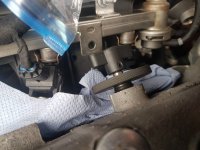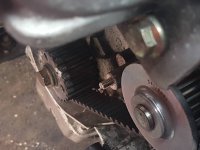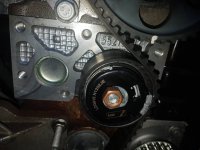Hey guys. I may not need it but better to be safe than sorry. Does anyone know the Phonic Wheel relearn process is you do NOT have Fiat software. Looking on forum but can only find people mentioning it but not actually how its done. Thanks in advance.
OK, I think I see where you're coming from with this - Your question is "How do I do a Phonic wheel relearn if I don't have
MES (or equivalent)"? Yes? I found myself wondering, slightly differently, "Does the ECU need to be reset in some way before performing the relearn"? I think both questions are rooted in the same area.
I've seen posts on the forum where people have been experiencing problems and tried to do the procedure with varying degrees of success. Of course I don't know how closely they've followed the recommendation but there seems to be a common thread, where mentioned, which is that most who have tried it when their MIL was flashing report success whereas those who did not comment about the light already flashing seem to be less successful? My guess, as I've said above, is that the ECU needs to be ready to receive the new parameters and it indicates this by flashing the MIL?
I have
MES so I can look at all models in simulation mode. If I go into either of the program for my Panda (or my boy's Punto), select "ENGINE" and highlight the relevant ECU and click "simulate" I can then click on "Adjustments" where I find "Phonic wheel learn reset" with the option to "Execute". On the right side of the screen there is guidance (as there is with most of the procedures) which I'll now write out for you:
Firstly there is a warning that if you initiate this procedure you must follow up by performing the phonic wheel learning procedure - "Your car will beep and blink to warn you this is needed to perform"
It then lists the procedure:
1. Start engine, wait until engine reaches working temperature
2. Rev the engine up to 5000-6000 rpm and let engine restore idle speed. Repeat another 2-3 times.
3. Turn the key off
3. Wait 10 sec and start the engine
I went into one of the 16 valve programs but it didn't list a phonic relearn in it's Adjustments?
This is the procedure which you will see people talking about on our forum. I'm guessing that when you punch the "Execute" command what it's doing is resetting the learned parameters and preparing the ECU to accept the new values it learns by performing the steps 1 to 4 listed above. If this is true then I'm confused as to how people report success by performing the 1 to 4 steps above without any prior intervention? Then again some people do report having no success? But then the people reporting success seem to say they're MIL was flashing before they tried? so maybe the ECU was, in some way I don't understand, already prepared to accept new values?
So, don't know if that's clarified things for you. If you are going to be doing your own maintenance in any depth though, I would just buy a basic version of
MES - You really can't go wrong.
https://www.multiecuscan.net/ Give the guys at Gendan a ring, say the forum recommended them to you - we are well known to then - and have a chat.
https://www.gendan.co.uk/# You'll learn a lot. If you decide to buy I would recommend being careful of some of the cheap options on the likes of eBay - there have been multiple reports of stuff which doesn't work right. I bought from Gendan and they were very helpful when my "stupid" elderly brain couldn't get itself around the likes of COM Ports and speeds etc.
PS. Having said all that, I didn't need to perform a relearn on either of our cars! So don't get too hung up about it. you may well find you don't need to do it.
Regards
Jock







